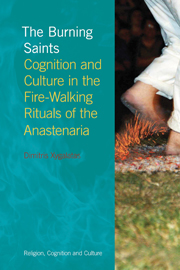Book contents
- Frontmatter
- Dedication
- Contents
- List of illustrations
- Acknowledgements
- 1 Introduction
- 2 Tradition in the making
- 3 The ethnographic setting
- 4 Fire-walking in Agia Eleni
- 5 Knowledge and revelation among the Anastenaria
- 6 Ritual and mind
- 7 Costly rituals
- 8 Arousal, emotion and motivation
- 9 The physiology of high-arousal rituals
- 10 Putting it all together
- Notes
- Bibliography
- Index
6 - Ritual and mind
- Frontmatter
- Dedication
- Contents
- List of illustrations
- Acknowledgements
- 1 Introduction
- 2 Tradition in the making
- 3 The ethnographic setting
- 4 Fire-walking in Agia Eleni
- 5 Knowledge and revelation among the Anastenaria
- 6 Ritual and mind
- 7 Costly rituals
- 8 Arousal, emotion and motivation
- 9 The physiology of high-arousal rituals
- 10 Putting it all together
- Notes
- Bibliography
- Index
Summary
Anthropologists are concerned with the study of recurrent patterns of human behaviour in its natural context. Such recurrent patterns depend both on historical and local circumstances and on the pan-human regularities of the human mind, as cognition and culture are interconnected and inseparable: on the one hand, human cognition always takes place within specific cultural frameworks that structure thought and behaviour in a host of ways (Samuel 1990); on the other hand, no culture could exist without interacting individual minds (Sperber 2006a, 2006b). Therefore, in order to study adequately any cultural expression, we need to understand its particular socio-historical context as well as to examine the underlying psychological mechanisms that lead to similar patterns of behaviour. Thus, with respect to our case in hand, if we wish to understand the particular cultural mindset of the Anastenaria, we must pay attention not only to the social, historical, political and other contextual factors that have contributed to its development, but also to those features of human psychology that drive similar ritual behaviours the world over.
This unity of the human condition might at first glance sound like a truism. After all, we all know that we are biological, psychological and socio-cultural beings at the same time, and that these levels of our existence are inseparable. However, it is not at all uncommon among those who study human behaviour to attribute ontological priority to one of these levels, underestimating or neglecting the rest. In fact, this attitude has been the rule rather than the exception both in anthropology and in the study of religion.
- Type
- Chapter
- Information
- The Burning SaintsCognition and Culture in the Fire-Walking Rituals of the Anastenaria, pp. 107 - 124Publisher: Acumen PublishingPrint publication year: 2012



